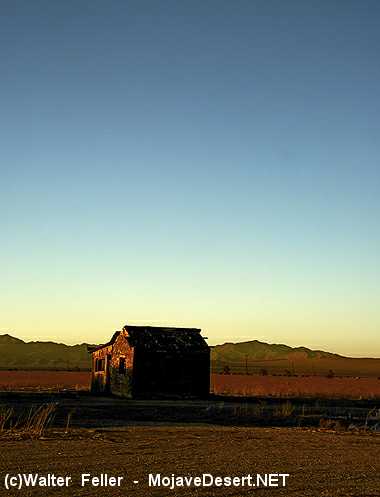Homesteaders in the Mojave
Starting in the early 1900s, land was homesteaded in the Mojave Desert.
In many areas 160-acre parcels were available. Claimants had three years to
“prove up” on their property. “Proving up” meant building a small cabin and an
outhouse. When the “proof,” a photo was mailed to Washington, D.C., the claimant
received a deed to the property.
There were several wet years beginning in 1912, and crops were good
enough to attract more people to the area. Veterans of World War I, suffering
the effects of mustard gas, came hoping to benefit from the dry desert air. Later,
because of hard times created by the Depression, some people sought out a
rural lifestyle where they could raise their own food without relying on
unstable markets and unpredictable prices.
But the rains didn’t last. The scarcity
of water led to conflicts between homesteaders and ranchers over water
rights. In the Mojave National Preserve the Rock Springs Land and Cattle
Company had enjoyed exclusive use of the water and the land for the last fifteen
years and had filed claims on them. Homesteaders drilled water wells, but
were unsuccessful. In many cases, water had to be hauled several miles even for
household purposes. Crops depended on rainfall. Several years passed with little
or no rainfall and the crops failed.
This scenario was repeated in many
areas. Besides the scarcity of water, life in the desert presented other challenges.
Temperatures were extreme for those used to more temperate climates. Few
homesteaders met the challenge. Many farms and small homesteads were
abandoned, leaving behind the tiny cabins which are still scattered about the desert in
some places.
<< Previous -
Next >>
Related pages:
History of Homesteading in the Mojave Preserve
The most famous of federal land laws was the Homestead Act, ... His homestead and several others became the heart of a community along the railroad, ...
Desert Queen Ranch
By 1917 Bill had increased the size of his remote homestead to over 160 acres. In the high desert country rugged individuals tried their luck at cattle ...
Ranching History in the Mojave Desert
Fleetwood "Fleet" Southcott Sr. came to the Gold Valley area in 1931, after losing his fortune in the Great Depression, and staked a homestead in Gold ...
Mojave Desert - Bill Keys
In 1917, he filed on an 80 acre homestead under the Homestead Act and began to build a ... Eventually, the Keys' homestead included a ranch house, store, ...
Periods of History in the Mojave Desert
During the 1900s a series of homestead acts brought many wishing to settle in the desert. These folks either came to the desert for their health or to get ...
Contents & Introduction
-
Paleo-Indians
Desert Indians
Spanish Explorers
American Explorers
Pioneers
Military
Prospectors & Miners
Ranchers
Railroads
Homesteaders
Route 66 & Hoover Dam
Modern Communities
